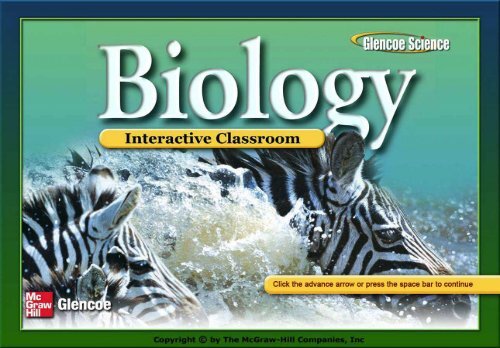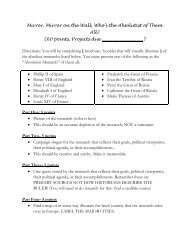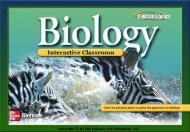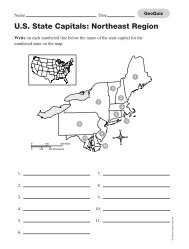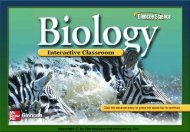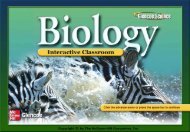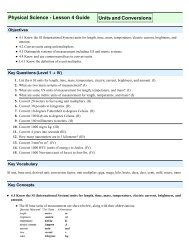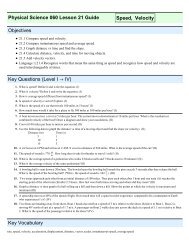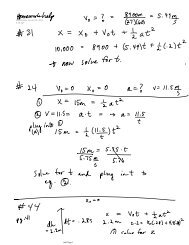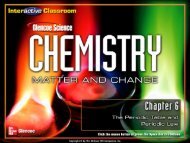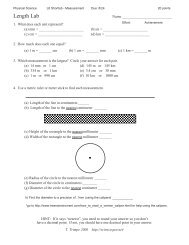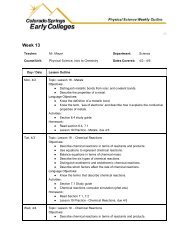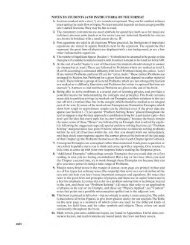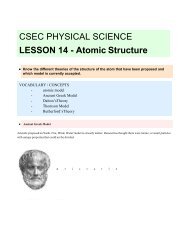Chapter 5 Biodiversity and Conservation.pdf
Chapter 5 Biodiversity and Conservation.pdf
Chapter 5 Biodiversity and Conservation.pdf
You also want an ePaper? Increase the reach of your titles
YUMPU automatically turns print PDFs into web optimized ePapers that Google loves.
<strong>Chapter</strong> 5 <strong>Biodiversity</strong> <strong>and</strong> <strong>Conservation</strong>Section 1: <strong>Biodiversity</strong>Section 2: Threats to <strong>Biodiversity</strong>Section 3: Conserving <strong>Biodiversity</strong>Click on a lesson name to select.
<strong>Chapter</strong> 5<strong>Biodiversity</strong> <strong>and</strong> <strong>Conservation</strong>5.1 <strong>Biodiversity</strong>What is biodiversity?• <strong>Biodiversity</strong> is the variety of life in an areathat is determined by the number of differentspecies in that area.• <strong>Biodiversity</strong> increases the stability of anecosystem <strong>and</strong> contributes to the health ofthe biosphere.
<strong>Chapter</strong> 5<strong>Biodiversity</strong> <strong>and</strong> <strong>Conservation</strong>5.1 <strong>Biodiversity</strong>• The variety of genes or inheritablecharacteristics that are present in a populationcomprises its genetic diversity.• Genetic diversity increases the chances thatsome species will survive during changingenvironmental conditions or during theoutbreak of disease.
<strong>Chapter</strong> 5<strong>Biodiversity</strong> <strong>and</strong> <strong>Conservation</strong>5.1 <strong>Biodiversity</strong>• The number ofdifferent species<strong>and</strong> the relativeabundance of eachspecies in abiologicalcommunity is calledspecies diversity.
<strong>Chapter</strong> 5<strong>Biodiversity</strong> <strong>and</strong> <strong>Conservation</strong>5.1 <strong>Biodiversity</strong>The Importance of <strong>Biodiversity</strong>• Most of the world’s food cropscome from just a few species.• Wild species serve as reservoirsof desirable genetictraits that might beneeded to improvedomestic cropspecies.Teosinte plantDomestic corn plant
<strong>Chapter</strong> 5<strong>Biodiversity</strong> <strong>and</strong> <strong>Conservation</strong>5.1 <strong>Biodiversity</strong>• A healthy biosphereprovides many servicesto humans <strong>and</strong> otherorganisms that liveon Earth.• Green plants provideoxygen to the atmosphere <strong>and</strong> removecarbon dioxide.• Natural processes provide drinking waterthat is safe for human use.
<strong>Chapter</strong> 5<strong>Biodiversity</strong> <strong>and</strong> <strong>Conservation</strong>5.2 Threats to <strong>Biodiversity</strong>Extinction Rates• The gradual process of species becomingextinct is known as background extinction.• Mass extinction is an event in which a largepercentage of all living species becomeextinct in a relatively short period of time.
<strong>Chapter</strong> 5<strong>Biodiversity</strong> <strong>and</strong> <strong>Conservation</strong>5.2 Threats to <strong>Biodiversity</strong>
<strong>Chapter</strong> 5<strong>Biodiversity</strong> <strong>and</strong> <strong>Conservation</strong>
<strong>Chapter</strong> 5<strong>Biodiversity</strong> <strong>and</strong> <strong>Conservation</strong>5.2 Threats to <strong>Biodiversity</strong>Factors that Threaten <strong>Biodiversity</strong>• The current high rate of extinction is due to theactivities of a single species—Homo sapiens.• Humans are changing conditions on Earthfaster than new traits can evolve to cope withthe new conditions.
<strong>Chapter</strong> 5<strong>Biodiversity</strong> <strong>and</strong> <strong>Conservation</strong>5.2 Threats to <strong>Biodiversity</strong>Overexploitation• Overexploitation, or excessive use, of species thathave economic value is a factor increasing thecurrent rate of extinction.• Bison• Passenger pigeons• Ocelot• RhinocerosRhinocerosOcelot
<strong>Chapter</strong> 5<strong>Biodiversity</strong> <strong>and</strong> <strong>Conservation</strong>5.2 Threats to <strong>Biodiversity</strong>Habitat Loss• If a habitat is destroyed or disrupted, the nativespecies might have to relocate or they will die.Destruction of Habitat• The destruction of habitat, such as the clearingof tropical rain forests, has a direct impact onglobal biodiversity.
<strong>Chapter</strong> 5<strong>Biodiversity</strong> <strong>and</strong> <strong>Conservation</strong>5.2 Threats to <strong>Biodiversity</strong>Disruption of Habitat• The decliningpopulation ofone speciescan affect anentireecosystem.
<strong>Chapter</strong> 5<strong>Biodiversity</strong> <strong>and</strong> <strong>Conservation</strong>5.2 Threats to <strong>Biodiversity</strong>Fragmentation of Habitat• The separation of an ecosystem into small piecesof l<strong>and</strong> is called habitat fragmentation.• The smaller the parcel of l<strong>and</strong>, the fewer species itcan support.• Fragmentation reduces the opportunities forindividuals in one area to reproduce with individualsfrom another area.• Carving the large ecosystem into small parcelsincreases the number of edges—creating edgeeffects.
<strong>Chapter</strong> 5<strong>Biodiversity</strong> <strong>and</strong> <strong>Conservation</strong>5.2 Threats to <strong>Biodiversity</strong>Pollution• Pollution <strong>and</strong> atmosphericchanges threaten biodiversity<strong>and</strong> global stability.• Biological magnification is theincreasing concentration oftoxic substances in organismsas trophic levels increase in afood chain or food web.
<strong>Chapter</strong> 5<strong>Biodiversity</strong> <strong>and</strong> <strong>Conservation</strong>5.2 Threats to <strong>Biodiversity</strong>Acid Precipitation• Sulfur <strong>and</strong> nitrogen compounds react withwater <strong>and</strong> other substances in the air to formsulfuric acid <strong>and</strong> nitric acid.• Acid precipitation removes calcium, potassium,<strong>and</strong> other nutrients from the soil, deprivingplants of these nutrients.AssessingWater Quality
<strong>Chapter</strong> 5<strong>Biodiversity</strong> <strong>and</strong> <strong>Conservation</strong>5.2 Threats to <strong>Biodiversity</strong>Eutrophication• Eutrophication occurs when substances richin nitrogen <strong>and</strong> phosphorus flow intowaterways, causing extensive algae growth.• The algae use up the oxygen supply duringtheir rapid growth <strong>and</strong> after their deathsduring the decaying process.• Other organisms in the water suffocate.
<strong>Chapter</strong> 5<strong>Biodiversity</strong> <strong>and</strong> <strong>Conservation</strong>5.2 Threats to <strong>Biodiversity</strong>Introduced Species• Nonnative species that are either intentionally orunintentionallytransported to anew habitat areknown asintroducedspecies.• Introduced species often reproduce in large numbersbecause of a lack of predators, <strong>and</strong> become invasivespecies in their new habitat.
<strong>Chapter</strong> 5<strong>Biodiversity</strong> <strong>and</strong> <strong>Conservation</strong>5.3 Conserving <strong>Biodiversity</strong>Natural Resources• The consumptionrate of naturalresources is notevenly distributed.
<strong>Chapter</strong> 5<strong>Biodiversity</strong> <strong>and</strong> <strong>Conservation</strong>5.3 Conserving <strong>Biodiversity</strong>• Resources that are replaced by naturalprocesses faster than they are consumedare called renewable resources.• Resources that are found on Earth in limitedamounts or those that are replaced by naturalprocesses over extremely long periods of timeare called nonrenewable resources.
<strong>Chapter</strong> 5<strong>Biodiversity</strong> <strong>and</strong> <strong>Conservation</strong>5.3 Conserving <strong>Biodiversity</strong>• Sustainable use means using resources at arate in which they can be replaced or recycledwhile preserving the long-term environmentalhealth of the biosphere.
<strong>Chapter</strong> 5<strong>Biodiversity</strong> <strong>and</strong> <strong>Conservation</strong>5.3 Conserving <strong>Biodiversity</strong>Protecting <strong>Biodiversity</strong>• Currently, about seven percent of the world’sl<strong>and</strong> is set aside as some type of reserve.• The United Nations supports a system ofBiosphere Reserves <strong>and</strong> World Heritage sites.
<strong>Chapter</strong> 5<strong>Biodiversity</strong> <strong>and</strong> <strong>Conservation</strong>5.3 Conserving <strong>Biodiversity</strong><strong>Biodiversity</strong> Hotspots• At least 1500 species of vascular plants areendemic.• The region must have lost at least 70 percent of itsoriginal habitat.• These hot spots originally covered 15.7 percent ofEarth’s surface, however, only about a tenth of thathabitat remains.Visualizing<strong>Biodiversity</strong>Hot Spots
<strong>Chapter</strong> 5<strong>Biodiversity</strong> <strong>and</strong> <strong>Conservation</strong>5.3 Conserving <strong>Biodiversity</strong>Corridors Between Habitat Fragments• Improve the survival of biodiversity by providingcorridors, or passageways, between habitatfragments• Creates a larger piece of l<strong>and</strong> that can sustaina wider variety of species <strong>and</strong> a wider variety ofgenetic variation
<strong>Chapter</strong> 5<strong>Biodiversity</strong> <strong>and</strong> <strong>Conservation</strong>5.3 Conserving <strong>Biodiversity</strong>Restoring Ecosystems• The larger theaffected area, thelonger it takes for thebiological communityto recover.
<strong>Chapter</strong> 5<strong>Biodiversity</strong> <strong>and</strong> <strong>Conservation</strong>5.3 Conserving <strong>Biodiversity</strong>Bioremediation• The use of livingorganisms, such asprokaryotes, fungi, orplants, to detoxify a polluted area is calledbioremediation.
<strong>Chapter</strong> 5<strong>Biodiversity</strong> <strong>and</strong> <strong>Conservation</strong>5.3 Conserving <strong>Biodiversity</strong>Biological Augmentation• Adding natural predators to a degradedecosystem is called biological augmentation.Ladybugs help control aphid populations.Photo courtesy of Nature’s Control
<strong>Chapter</strong> 5<strong>Biodiversity</strong> <strong>and</strong> <strong>Conservation</strong><strong>Chapter</strong> Resource Menu<strong>Chapter</strong> Diagnostic QuestionsFormative Test Questions<strong>Chapter</strong> Assessment QuestionsSt<strong>and</strong>ardized Test Practicebiologygmh.comGlencoe Biology TransparenciesImage BankVocabularyAnimationClick on a hyperlink to view the corresponding lesson.
<strong>Chapter</strong> 5<strong>Biodiversity</strong> <strong>and</strong> <strong>Conservation</strong><strong>Chapter</strong> DiagnosticQuestionsWhich factor is most responsible for thelack of plants in polar regions?A. heavy grazing by herbivoresB. little precipitationC. no soil for plants to take rootD. not enough sunlight
<strong>Chapter</strong> 5<strong>Biodiversity</strong> <strong>and</strong> <strong>Conservation</strong><strong>Chapter</strong> DiagnosticQuestionsWhat form of pollution is caused byextensive algae growth in waterways?A. acid precipitationB. eutrophicationC. biological magnificationD. edge effects
<strong>Chapter</strong> 5<strong>Biodiversity</strong> <strong>and</strong> <strong>Conservation</strong><strong>Chapter</strong> DiagnosticQuestionsWhich is not a renewable resource?A. solar energyB. fossil fuelsC. agricultural plantsD. clean water
<strong>Chapter</strong> 5<strong>Biodiversity</strong> <strong>and</strong> <strong>Conservation</strong>5.1 FormativeQuestionsWhich has indirect economic value?A. ecosystems that decompose wastesB. organisms that provide food <strong>and</strong> shelterC. plants that contain medicinal substancesD. species that have desirable genetic traits
<strong>Chapter</strong> 5<strong>Biodiversity</strong> <strong>and</strong> <strong>Conservation</strong>5.1 FormativeQuestionsTrue or FalseIt is likely that some of the world’sunidentified species will have economicvalue.
<strong>Chapter</strong> 5<strong>Biodiversity</strong> <strong>and</strong> <strong>Conservation</strong>5.1 FormativeQuestionsWhen does the aesthetic value of an ecosystembecome most apparent?A. when scientists begin to study the ecosystemB. when the ecosystem has been destroyedC. when the ecosystem is given economic valueD. when the ecosystem provides usefulservices
<strong>Chapter</strong> 5<strong>Biodiversity</strong> <strong>and</strong> <strong>Conservation</strong>5.2 FormativeQuestionsWhich describes the current rate of speciesdisappearance?A. background extinctionB. mass extinctionC. natural extinctionD. progressive extinction
<strong>Chapter</strong> 5<strong>Biodiversity</strong> <strong>and</strong> <strong>Conservation</strong>5.2 FormativeQuestionsWhere are most extinctions likely to occurin the near future?A. desertsB. grassl<strong>and</strong>sC. tropical forestsD. temperate forests
<strong>Chapter</strong> 5<strong>Biodiversity</strong> <strong>and</strong> <strong>Conservation</strong>5.2 FormativeQuestionsWhat is the primary factor that has endangeredthe North American bison <strong>and</strong> the whiterhinoceros?A. habitat lossB. eutrophicationC. overexploitationD. nonnative predators
<strong>Chapter</strong> 5<strong>Biodiversity</strong> <strong>and</strong> <strong>Conservation</strong>5.2 FormativeQuestionsWhat is the number one cause of speciesextinction today?A. habitat lossB. human predatorsC. transported diseasesD. background extermination
<strong>Chapter</strong> 5<strong>Biodiversity</strong> <strong>and</strong> <strong>Conservation</strong>5.3 FormativeQuestionsWhich resource is nonrenewable?A. agricultural plantsB. clean waterC. forest timberD. mineral deposits
<strong>Chapter</strong> 5<strong>Biodiversity</strong> <strong>and</strong> <strong>Conservation</strong>5.3 FormativeQuestionsFor which human activity is sustainableuse not possible?A. farmingB. loggingC. oil drillingD. commercial fishing
<strong>Chapter</strong> 5<strong>Biodiversity</strong> <strong>and</strong> <strong>Conservation</strong>5.3 FormativeQuestionsWhich is an example of bioremediation?A. replanting trees in an area affected byacid rainB. using microorganisms to detoxify an oil spillC. enacting a law that protects endangeredamphibiansD. introducing natural predators to controla crop pest
<strong>Chapter</strong> 5<strong>Biodiversity</strong> <strong>and</strong> <strong>Conservation</strong><strong>Chapter</strong> AssessmentQuestionsLook at the following figure.Name the process that isoccurring with theincreasing concentrationof DDT.
<strong>Chapter</strong> 5<strong>Biodiversity</strong> <strong>and</strong> <strong>Conservation</strong><strong>Chapter</strong> AssessmentQuestionsA. pollutionB. extinctionC. biological magnificationD. habitat fragmentation
<strong>Chapter</strong> 5<strong>Biodiversity</strong> <strong>and</strong> <strong>Conservation</strong><strong>Chapter</strong> AssessmentQuestionsUse the graph todetermine theapproximaterecovery time fora volcanic eruption.
<strong>Chapter</strong> 5<strong>Biodiversity</strong> <strong>and</strong> <strong>Conservation</strong><strong>Chapter</strong> AssessmentQuestionsA. 1-10 yearsB. 10-100 yearsC. 100-1000 yearsD. 1000 years ormore
<strong>Chapter</strong> 5<strong>Biodiversity</strong> <strong>and</strong> <strong>Conservation</strong><strong>Chapter</strong> AssessmentQuestionsExplain how killer whales adapted to theirenvironment when their primary food sourcebegan to disappear.Answer: Killer whales started to prey onsea otters instead of sea lions<strong>and</strong> harbor seals.
<strong>Chapter</strong> 5<strong>Biodiversity</strong> <strong>and</strong> <strong>Conservation</strong>St<strong>and</strong>ardized TestPracticeWhich type of biodiversity increases as youmove geographically from the polar regionsto the equator?A. ecosystem diversityB. genetic diversityC. social diversityD. species diversity
<strong>Chapter</strong> 5<strong>Biodiversity</strong> <strong>and</strong> <strong>Conservation</strong>St<strong>and</strong>ardized TestPracticeHow does genetic diversity increase a species’chance of survival?A. It increases the number of organisms that haveuseful genes.B. It increases the ability of a species to adapt toenvironmental changes.C. It produces a variety of species within abiological community.D. It r<strong>and</strong>omly distributes members of a speciesthroughout an ecosystem.
<strong>Chapter</strong> 5<strong>Biodiversity</strong> <strong>and</strong> <strong>Conservation</strong>St<strong>and</strong>ardized TestPracticeIf a toxic substance enters this food web, whichanimals will have the highest concentration ofthe toxic substancein their tissues?A. fishesB. killer whalesC. sea ottersD. sea urchins
<strong>Chapter</strong> 5<strong>Biodiversity</strong> <strong>and</strong> <strong>Conservation</strong>St<strong>and</strong>ardized TestPracticeWhat type of substances causeseutrophication of aquatic ecosystems?A. acid rainB. fertilizersC. PCBsD. pesticides
<strong>Chapter</strong> 5<strong>Biodiversity</strong> <strong>and</strong> <strong>Conservation</strong>St<strong>and</strong>ardized TestPracticeWhich factor has the greatest impact on acountry’s rate of naturalresource consumption?A. l<strong>and</strong> areaB. populationC. industrializationD. availability ofresources
<strong>Chapter</strong> 5<strong>Biodiversity</strong> <strong>and</strong> <strong>Conservation</strong>St<strong>and</strong>ardized TestPracticeWhich event has the greatest potential tocause irreversibledamage to biodiversity?A. oil spillB. urbanizationC. industrial pollutionD. modern agriculture
<strong>Chapter</strong> 5<strong>Biodiversity</strong> <strong>and</strong> <strong>Conservation</strong>Glencoe Biology Transparencies
<strong>Chapter</strong> 5<strong>Biodiversity</strong> <strong>and</strong> <strong>Conservation</strong>Image Bank
<strong>Chapter</strong> 5<strong>Biodiversity</strong> <strong>and</strong> <strong>Conservation</strong>VocabularySection 1extinctionbiodiversitygenetic diversityspecies diversityecosystem diversity
<strong>Chapter</strong> 5<strong>Biodiversity</strong> <strong>and</strong> <strong>Conservation</strong>VocabularySection 2backgroundextinctionmass extinctionnatural resourceoverexploitationhabitatfragmentationedge effectbiologicalmagnificationeutrophicationintroduced species
<strong>Chapter</strong> 5<strong>Biodiversity</strong> <strong>and</strong> <strong>Conservation</strong>VocabularySection 3renewable resourcenonrenewable resourcesustainable useendemicbioremediationbiological augmentation
<strong>Chapter</strong> 5<strong>Biodiversity</strong> <strong>and</strong> <strong>Conservation</strong>Animation• Visualizing <strong>Biodiversity</strong> Hot Spots


